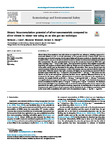Dietary bioaccumulation potential of silver nanomaterials compared to silver nitrate in wistar rats using an ex vivo gut sac technique
| dc.contributor.author | Clark, Nathaniel | |
| dc.contributor.author | Woznica, W | |
| dc.contributor.author | Handy, Richard | |
| dc.date.accessioned | 2020-05-29T08:37:04Z | |
| dc.date.available | 2020-05-29T08:37:04Z | |
| dc.date.issued | 2020-09-01 | |
| dc.identifier.issn | 0147-6513 | |
| dc.identifier.issn | 1090-2414 | |
| dc.identifier.other | 110745 | |
| dc.identifier.uri | http://hdl.handle.net/10026.1/15718 | |
| dc.description.abstract |
Chronic dietary bioaccumulation tests with rodents are required for new substances, including engineered nanomaterials (ENMs), in order to provide information on the potential hazards to human health. However, screening tools are needed to manage the diversity of ENMs and alternative methods are desirable with respect to animal welfare. Here, an ex vivo gut sac method was used to estimate the dietary bioaccumulation potential of silver nanomaterials. The entire gastrointestinal tract (except the caecum) was removed and filled with a gut saline containing 1 mg L-1 of Ag as either AgNO3, silver nanoparticles (Ag NPs) or silver sulphide nanoparticles (Ag2S NPs), and compared to controls with no added Ag. The gut sacs were incubated for 4 h, rinsed to remove excess media, and the total Ag determined in the mucosa and muscularis. There was no detected Ag in the control treatments. Within the Ag treatments, 1.4-22% of the exposure dose was associated with the tissues and serosal saline. Within the mucosa of the AgNO3 treatment, the highest Ag concentration was associated with the intestinal regions (3639-7087 ng g-1) compared to the stomach (639 ± 128 ng g-1). This pattern was also observed in the Ag NP and Ag2S NP treatments, but there was no significant differences between any Ag treatments for the mucosa. However, differences between treatments were observed in the muscularis concentration. For example, both the Ag NP (907 ± 284 ng g -1) and Ag2S NP (1482 ± 668 ng g-1) treatments were significantly lower compared to the AgNO3 treatment (2514 ± 267 ng g-1). The duodenum demonstrated serosal accumulation in both the AgNO3 (~10 ng mL-1) and Ag NP (~3 ng mL-1) treatments. The duodenum showed some of the highest Ag accumulation with 41, 61 and 57% of the total Ag in the mucosa compared to the muscularis for the AgNO3, Ag NP and Ag2S NP treatments, respectively. In conclusion, the ex vivo gut sac method demonstrates the uptake of Ag in all Ag treatments, with the duodenum the site of highest accumulation. Based on the serosal saline accumulation, the ranked order of accumulation is AgNO3 > Ag NPs > Ag2S NPs. | |
| dc.format.extent | 110745-110745 | |
| dc.format.medium | Print-Electronic | |
| dc.language | en | |
| dc.language.iso | en | |
| dc.publisher | Elsevier BV | |
| dc.subject | Gut exposure | |
| dc.subject | Silver sulphide nanoparticles | |
| dc.subject | Bioavailability | |
| dc.subject | Alternative methods | |
| dc.subject | 3Rs | |
| dc.subject | Rapid testing | |
| dc.title | Dietary bioaccumulation potential of silver nanomaterials compared to silver nitrate in wistar rats using an ex vivo gut sac technique | |
| dc.type | journal-article | |
| dc.type | Comparative Study | |
| dc.type | Journal Article | |
| plymouth.author-url | https://www.webofscience.com/api/gateway?GWVersion=2&SrcApp=PARTNER_APP&SrcAuth=LinksAMR&KeyUT=WOS:000539092800011&DestLinkType=FullRecord&DestApp=ALL_WOS&UsrCustomerID=11bb513d99f797142bcfeffcc58ea008 | |
| plymouth.volume | 200 | |
| plymouth.publication-status | Published | |
| plymouth.journal | Ecotoxicology and Environmental Safety | |
| dc.identifier.doi | 10.1016/j.ecoenv.2020.110745 | |
| plymouth.organisational-group | /Plymouth | |
| plymouth.organisational-group | /Plymouth/Faculty of Science and Engineering | |
| plymouth.organisational-group | /Plymouth/Faculty of Science and Engineering/School of Biological and Marine Sciences | |
| plymouth.organisational-group | /Plymouth/REF 2021 Researchers by UoA | |
| plymouth.organisational-group | /Plymouth/REF 2021 Researchers by UoA/UoA06 Agriculture, Veterinary and Food Science | |
| plymouth.organisational-group | /Plymouth/REF 2021 Researchers by UoA/UoA07 Earth Systems and Environmental Sciences | |
| plymouth.organisational-group | /Plymouth/Research Groups | |
| plymouth.organisational-group | /Plymouth/Research Groups/Marine Institute | |
| plymouth.organisational-group | /Plymouth/Users by role | |
| plymouth.organisational-group | /Plymouth/Users by role/Academics | |
| dc.publisher.place | Netherlands | |
| dcterms.dateAccepted | 2020-05-12 | |
| dc.rights.embargodate | 2021-5-24 | |
| dc.identifier.eissn | 1090-2414 | |
| dc.rights.embargoperiod | Not known | |
| rioxxterms.versionofrecord | 10.1016/j.ecoenv.2020.110745 | |
| rioxxterms.licenseref.uri | http://www.rioxx.net/licenses/all-rights-reserved | |
| rioxxterms.licenseref.startdate | 2020-09-01 | |
| rioxxterms.type | Journal Article/Review |


